Parent Connection
During the first few years of a child’s life, the foundation for intellectual and moral growth is established. Children who don’t get essential nurturing are likely to be two or three steps behind, no matter how hard teachers try to help them catch up. The way a parent nurtures a child has a profound effect on the child’s development. Although peer relationships are important, they build on the relationship that a child has with his parents. Learning problems are difficult to fix but very easy to prevent. The foundations of learning are established from the moment a child first hears the sounds of people talking, the melodies of songs, and the rhymes of Mother Goose. Children who from birth have not regularly experienced speaking interactions, playing, or hearing books read, find life at school much more wearisome than they otherwise might. Learning to read can become a major stumbling block rather than a magical delight.
-
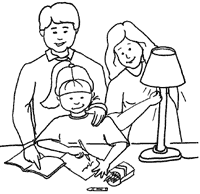 Children need a warm, intimate relationship with a primary care
giver. This is far more important to emotional and intellectual
development than “educational” games. Whenever a child is fed,
cuddled, played with, talked with, sung to, or read to, crucial
connections are made that determine how clever, creative, social,
and capable a child may be.
Children need a warm, intimate relationship with a primary care
giver. This is far more important to emotional and intellectual
development than “educational” games. Whenever a child is fed,
cuddled, played with, talked with, sung to, or read to, crucial
connections are made that determine how clever, creative, social,
and capable a child may be. -
Children need proper nutrition to develop a strong, healthy brain.
-
Children need an environment that protects them from physical and psychological harm. They need rest, exercise, and exposure to the amazing world around them and protection from exposure to violence and unrealistic expectations.
-
Children need structure and discipline. They need adults who empathize as well as set limits. They need adults who believe in their potential but understand their weaknesses.
-
Children need to grow up in a stable community with continuity of values in family, peer groups, religion, culture, and acceptance of diversity.
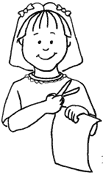 Parent Connection to
Fine Motor Development
Parent Connection to
Fine Motor Development
Fine motor development plays an integral part in your child’s school performance. Children need well-rounded playtime with opportunity to develop both large and small motor control. Your child’s chosen “play activities” will have an enormous influence on his ability to focus and to enjoy schoolwork. The toys your child plays with will impact his motor development.
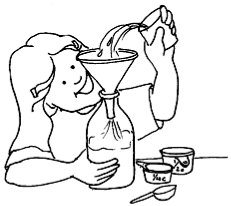 What makes a good toy? A good toy invites a child to
participate and discover. It suits a child’s developmental level.
The toy is open-ended, unstructured, appealing to the senses,
and fun. A good toy reflects positive values for interacting
with others and includes different racial and cultural
backgrounds. It should be durable, well made, and able to
fulfill a need for particular kinds of play in artistic, musical,
mathematical, dramatic, scientific, social, emotional, and
physical growth. For more information see
www.truceteachers.org.
What makes a good toy? A good toy invites a child to
participate and discover. It suits a child’s developmental level.
The toy is open-ended, unstructured, appealing to the senses,
and fun. A good toy reflects positive values for interacting
with others and includes different racial and cultural
backgrounds. It should be durable, well made, and able to
fulfill a need for particular kinds of play in artistic, musical,
mathematical, dramatic, scientific, social, emotional, and
physical growth. For more information see
www.truceteachers.org.
The the following list provides helpful ideas on the kinds of activities that enhance fine motor development (activities that strengthen the same three fingers used in handwriting).
Activities that Enhance Fine Motor Development
|
|
|
K-2 Parent Connection to Literacy
The best time to start reading aloud to a child is the day that he or she is born. Experts tell us that children need to hear a thousand stories read aloud before they begin to learn to read for themselves. Three stories a day will provide your child with a thousand stories in one year alone! You can do it! Children who are read to regularly in the home and have parents who are habitual readers themselves, become early readers who show a natural interest in books.
Words are an essential building block for literacy development. The more language a child experiences through books and conversation with others, the firmer his foundation in literacy becomes. Many people believe that TV provides the needed language enrichment, but television doesn’t develop the child’s ability to speak. Simply hearing language spoken does not develop the child’s expressive vocabulary. It is talking with others about seemingly ordinary things such as newspaper ads, cereal boxes, and books that enable a child to make critical connections, laying the foundation for becoming a successful reader.
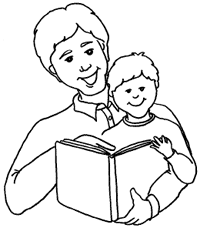 During the school year, there are several important things you can do
to provide structural support for homework. These might include:
During the school year, there are several important things you can do
to provide structural support for homework. These might include:
- Ask your child to see his schoolwork each day.
- Praise your child’s efforts.
- Acknowledge your child’s growth in abilities.
- Establish a consistent time and place in the house to do homework, preferably a quiet place with simple supplies available, turning off the TV.
- Keep incomplete homework, library books, etc. in a designated place.
- Post a schedule on the refrigerator as a reminder of homework, sharing, and library day.
- Keep completed homework in the backpack the child takes to school each day.
- Review homework with your child. Homework should be limited to approximately five minutes for kindergarten, 10 minutes for first grade, and 15 minutes for second grade. In addition, you should also plan 20-30 minutes of reading aloud to your child.
Environmental Print
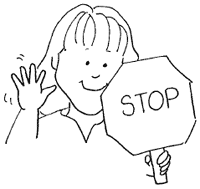 Help your child become aware of print in the
environment.
Help your child become aware of print in the
environment.
- Label your child’s belongings with his name (inside jacket, backpack, crayon box, etc.) Help your child to identify his name.
- Let your child show off all the words he recognizes. Ask him to read signs, video covers, newspaper ads, cereal boxes, etc., and make a collection of print your child can read all by himself.
- Encourage your child to make a collection (e.g., ads for desired toys, stamps, trading cards, coupons, books about insects).
- Help your child identify letters he sees in the world around him (e.g., find letters on signs when driving in the car or letters he knows in the newspaper, identify letters on the tapes in your family video collection).
Phonemic Awareness
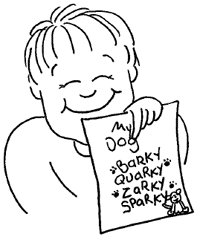 Help your child hear sounds that make up words.
Help your child hear sounds that make up words.
- Read books that rhyme and have fun language.
- Play with language by singing, pointing out signs, rhyming words, and talking about words and letters.
- Clap the syllables of names and words.
- Read a variety of poems and nursery rhymes with your child. Encourage your child to fill in the blank with a rhyming word as you read the rhyming text.
- Help your child think of other words that begin with the same beginning sound (Mary, mop, man, mom, money).
- Help your child to hear and recognize the non-matching sound or word (cat, car, can, tip).
- Ask your child to clap the syllables in words.
- Say a word by segmenting the syllables (tam-bour-ine) and ask your child to identify the word.
- Ask your child to say a word slowly, telling you the sounds he hears in a word (mmmaaaannn).
- Play sound manipulation games with your child where you substitute a new sound in a word (Willaby Wallaby, Apples and Bananas).
Print Messages
Help your child understand that print carries a message.
- Ask your child to identify the front, back, top, and bottom of a book.
- As you read aloud to your child, encourage him to turn the pages in the right direction.
- Ask your child, “What do we read, the text or the pictures?”
- Talk with your child about the pictures in a book. Teach him that the pictures are related to what the text says.
- Help your child to know what the word “title,” “author,” and “illustrator” mean.
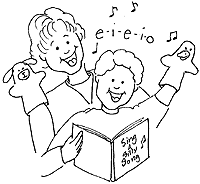 Pronunciation and Comprehension
Pronunciation and Comprehension
Help your child pronounce and comprehend grade level vocabulary.
- Talk about what you see in the world around you.
- Talk about the things that happen in your lives. For example, as you are working in the kitchen, describe your actions to your child.
- Ask questions to stimulate conversations.
- Sing together.
- Talk about the books you share. Ask your child to describe what she sees in the pictures, what will happen next, etc.
- Tell family stories.
- Retell stories and events that happen to your child.
- Listen to storytellers at the library or bookstore, and discuss the books read aloud.
- Act out stories or make puppets of story characters.
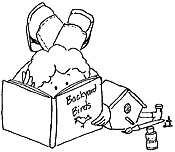 Literature Appreciation
Literature Appreciation
Help your child enjoy both narrative and nonfiction books.
- Point out newspaper articles, ads, or pamphlets that your child might find interesting.
- Give books as gifts for special occasions.
- Check out nonfiction books from your library (e.g., books about holidays, plants, animals, foreign countries, dinosaurs, and famous people).
- Stimulate your child’s interest in his collection (help your child sort and label collection items and look up items in a field guide).
- Plan a family vacation, and involve your child in finding locations on maps, charting routes, and identifying significant places to visit.
- As your child shows interest in the world around him or her, provide appropriate books on a variety of reading levels. (If your child shows interest in fishing, provide books about all kinds of fish.)
- Point out on-the-job informational reading for occupations (e.g., firemen must read maps, truck drivers must read road signs, cooks must read recipes, etc.)
Decoding Strategies
Help your child use phonics skills to decode words.
- Encourage your child to practice reading letters and sounds by reading to siblings, relatives, neighbors, pets, teddy bears, into tape recorders, etc.
- When your child practices saying letter names and sounds, take care to give enough time for your child to correct his mistakes. Tell your child the names of people or places in your child’s world that begin with that letter.
- Help your child use letter sounds as she independently writes words. Ask your child to say a word slowly so she can hear the sounds that make up the word.
- Play games involving making words. Ask your child to look for patterns in words and how to make new words by changing one letter or more (man, pan, ran, can).
- Provide your child with letter manipulatives such as wooden letters, magnet letters, and flashcards.
Written Communication
 Help your child to convey written thoughts and messages.
Help your child to convey written thoughts and messages.
- Provide writing materials (e.g., paper, pens, white boards, and markers).
- Take pictures and make a book about your child as he or she grows up.
- Provide letter activities for your child (e.g., magnetic letters, plastic letters).
- Have your child dictate a story to you and make it into a simple book.
- When your child draws, scribbles, or writes random letters, ask him or her to tell you about the writing or drawing.
- Respond enthusiastically to early attempts to write.
- Encourage temporary spelling rather than you spelling the words for your child, so he can become an independent writer (e.g., ask, “What sounds do you hear?”).
- Write a story together.
Comprehension Strategies
Help your child use comprehension strategies to understand what she reads, hears, or views
- Have a cozy reading corner that invites reading. Snuggle up on the couch or hold your child on your lap.
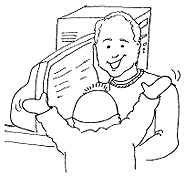 Reading at bedtime is a wonderful way to end the day. Share
your love of books and reading. Read favorite stories and poems.
Reading at bedtime is a wonderful way to end the day. Share
your love of books and reading. Read favorite stories and poems.- Children at this age enjoy books with pictures that match their age and interests. They like books with rhythm, rhyme, and repetition.
- Make singing and talking together part of your daily routine.
- Talk about the story and pictures in the books you read together.
- Buy or make tapes of favorite songs and books to listen to at home or in the car.
- Encourage children to take risks as they learn to read and memorize their first books. Have your child join in on repeat lines or a chorus.
- Take books everywhere you go. Keep books in the car and in every room.
- Ask your child to guess what will happen next as you read aloud.
- Tell stories and ask family members and friends to tell stories.
- Encourage your child to tell stories from magazine pictures or photographs.
Parent Connection to Mathematics
In order for young children to grasp mathematical concepts, experiences in math must be rich, varied, and relevant. Parents provide an important key in enabling children to make a connection between math concepts and the world around them. Most parents recognize the importance of reading aloud to their children and demonstrating the need for words in their daily lives. Parents can also help children to see the interaction of investigating, problem solving, measuring, reasoning, and communicating in their daily lives.
Number Sense
Children develop a foundation of problem solving skills when they are taught to understand the role of numbers and the tools of using addition, subtraction, multiplication, and division. Numbers enable us to communicate quantity and frequency.
 Help your child find all the appliances in your home that use
numbers (e.g., computers, phones, microwaves, clocks, radio, TV,
etc.).
Help your child find all the appliances in your home that use
numbers (e.g., computers, phones, microwaves, clocks, radio, TV,
etc.).- Play board games where your child must figure the number combinations on dice (or dominoes).
- Let your child place the candles on a clay dough birthday cake to represent the ages for each family member.
- Discuss the procedure for cutting pizza, cakes, etc. into equal pieces. Let your child try to cut a banana or sandwich to create equal size pieces. Discuss how many pieces they cut it into.
- Ask your child to show you a particular quantity with their fingers using different modes. For example ask them to show five with their fingers on one hand, or on two hands (with two fingers on one hand and three fingers on the other).
- Play “Bears in the Cave” by setting out a set of objects to explore (five bears). Then take turns playing hide and seek with one child covering their eyes while a family member takes some of the bears and hides them in the cave (overturned container) but leaving the other bears in view. The child tries to guess how many bears are hiding in the cave.
- Play “Bean Bag Toss” by laying three hoops on the floor labeled 1, 2, and 3. Children take turns tossing a beanbag into one of the hoops. If it lands inside a hoop they get that number of counters. The person with the most counters at the end of the game is the winner.
- Help your child to count objects, then help them learn to “count on.” For example, if they already know they have four pieces of candy, they say the number of objects they have and then count each of the new pieces “four, five, six, seven....” Ask your child how many they would have if they were given three more. Over time, children will perform the necessary arithmetic in their heads through mental problem solving.
- Ask your child how many place settings your family will need set at the table. As you place the cups on the table for them to distribute, ask them if there will be enough for everyone. How many more do we need?
- Have your child count the number of windows, doors, chairs, spoons, shoes, etc. there are in your home.
Patterns and Relationships
Thinking about patterns helps a child make sense of mathematics. They learn that mathematics is not a handful of unrelated facts and procedures. Recognizing and working with patterns helps young children to predict what will happen, talk about relationships, and make connections between concepts and experiences they have in the world around them.
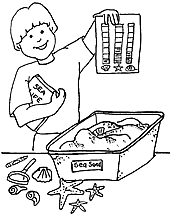 Help your child identify patterns found in the fabric of
their clothes (stripes and alternating shapes). Have them
orally describe the pattern or tell what shape or color
would come next in the pattern.
Help your child identify patterns found in the fabric of
their clothes (stripes and alternating shapes). Have them
orally describe the pattern or tell what shape or color
would come next in the pattern.- Help your child find patterns on a calendar (days of the week, odd and even numbers, weather conditions, holidays, etc.)
- Create a “clap-pat” pattern as you listen to songs together in the car.
- Ask your child to put fruit on a skewer, placing fruit into a pattern for a snack (strawberry, cherry, grape, strawberry, cherry, grape, etc.).
- Let your child create a necklace of multicolor cereal following a pattern (such as fruit loops).
- Help your child translate a pattern into different modalities. Decide on an action for each color in a pattern such as “jump on the red stripe, hop on the yellow.”
- Count by twos, fives, tens, etc.
- Ask your child questions such as: “How are these alike? How are they different? Do you see a pattern? Tell me about it. How can we remember this pattern? How can we make a picture that will help us remember it? Could you dance a pattern? What happens over and over again with these beads?”
- Let your child create their own patterns on the sidewalk with chalk.
- Conduct a family moon watch every day for a month. Have your child cut a paper plate to show the size and shape of the moon.
- Make dippy patterns by folding a paper towel several times, and dipping the corners of the folded towel in a food coloring/water solution. Open the towel and let it dry.
- Look at a book about snakes and study the variety of patterns on snake’s skins. Let your child make his own paper snake with a patterned skin.
Geometry
An awareness of shape, size, direction, and movement helps a child classify the physical world we live in. Children will develop a spatial sense that increases their awareness of themselves in relation to the people and objects in the world around them.
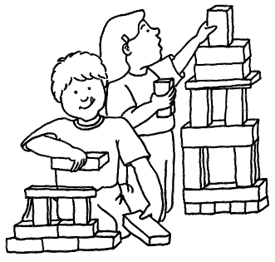 Ask your child questions about the
position of objects in relation to other
objects. For example; “What is above
the refrigerator? What is under the table? What cereal is on the
bottom shelf? Who is sitting nearest you?”
Ask your child questions about the
position of objects in relation to other
objects. For example; “What is above
the refrigerator? What is under the table? What cereal is on the
bottom shelf? Who is sitting nearest you?”- Have your child make comparisons: larger-smaller, heavierlighter, rounder-flatter, highest-lowest.
- Have a shape treasure hunt in the grocery store: circles (pizza, bologna); triangles (cheese, chips); squares (spice can, soda crackers); rectangles (laundry soap, cereal boxes).
- Bake cookies in geometric shapes. Predict how many of each shape could be cut out of rolled dough. How could you cut the most out at one time?
- Make a shape mobile from a clothes hanger. Draw, cut, and hang shapes with string on the hanger.
- Identify shapes in the environment as you drive down the road. Ask children to find specific shapes in the world.
- Describe home objects that are three-dimensional shapes: canscylinders, boxes-rectangular prisms, balls-spheres, dice-cubes.
- Combine a mirror with building blocks. Let your children build towers right on a large mirror that has been placed on a low table or floor. (The reflection increases their creative building.)
- Play a matching game building a figure out of shapes and describing the placement of each shape. Sitting back-to-back, let your child try to build a matching set by following your oral directions. Compare the figures. Trade places and let your child describe their figure building process while you attempt to follow his instructions and recreate his figure.
- Sort buttons by color, size, shape, number of holes, etc. Sort several times in several ways.
- Sort animal pictures by size, color, family, number of legs, what they eat, wild or domestic, covering (scales, fur, feathers, shell, etc.).
Measurement
Young children encounter many situations in which they want to compare things or judge how big, how long, or how deep they are. They are constantly measuring how big, how tall, how old, and how heavy they are compared to their friends. In daily experiences such as choosing the biggest cookie or pouring juice into a glass, children use and develop their intuitive notions of size comparisons.
 Help your child learn about the value of money. Help him
or her locate prices marked on items at the store. Show him or
her the price of a small, medium, and large container. Talk about
how the price is determined by the size of the container.
Help your child learn about the value of money. Help him
or her locate prices marked on items at the store. Show him or
her the price of a small, medium, and large container. Talk about
how the price is determined by the size of the container. - Let your child select a few things to purchase at the store. Give him or her money to pay for the items. Let him or her observe how the prices are recorded on the cash register, and how people receive change on the money given to the cashier.
- Show your child how to weigh themselves on the household bathroom scales. As you go places look for scales used in local businesses (fresh produce section in the grocery store, delicatessen shop, checkout stand, truck weigh station, hardware stores, candy stores, seed and feed stores, kitchen scales, etc.)
- Create a simple balance scale by attaching two bags to a skirt hanger and suspending it on a doorknob. (You may need to slide the clips to adjust the balance.) Help the child compare weights of potatoes, toys, or household items.
- Look at the weight information on packages. Read aloud to your child how much the package weighs. Compare the package with other items in your cupboard. Ask your child to guess which items will weigh more.
- Make a growth chart, keeping track of the child’s height and weight over a period of time. Measure the height of each family member and mark it on the same chart.
- Show your child the different sizes of containers for milk, or soft drinks. Name and compare the different sizes of containers. Talk about why people purchase different sizes. Show your child the labels telling the ounces or grams. Compare the price and size of a six-ounce can of juice and a 48-ounce can.
- Let your child play with various sizes of plastic containers in the bathtub. Encourage your child to pour water from one container to another. Ask how many smaller containers of water can be poured into a larger container.
- Talk to your child about how far you live from the store. Measure the distance in blocks or miles. Show him or her the speedometer that shows how fast you’re going, and the odometer that shows how far you have gone.
- Compare lengths of shoelaces, various sizes of pants, etc.
- Help your child to measure the length of things with different objects, (e.g., how many crayons long is the table). For very young children use multiple units such as the length of 10 crayons end to end rather than trying to mark a distance repeatedly using only one unit.
- Discuss the importance of measuring objects in your daily life. What size bed sheets do we need for your bed? How far is it to school?, etc.
- Help your child find all the clocks and watches in your house. Look at an alarm clock and talk about why you have clocks in your home.
- Make a paper plate clock and discuss with your child the times he goes to bed, gets up, eats lunch, comes home from school, etc.
Use of Data
Children love to ask questions. Children learn a great deal thinking about and discussing how to collect data on a variety of questions that are important to them.
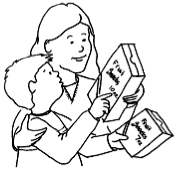 Have your family choose between two main dish
meals or two restaurants. All of those who want
pizza hold hands, and all of those that want
hamburgers hold hands. Family members in one line
shake hands with family members in the other line.
Are there people left over without a partner? Compare lines:
Which is longer?
Have your family choose between two main dish
meals or two restaurants. All of those who want
pizza hold hands, and all of those that want
hamburgers hold hands. Family members in one line
shake hands with family members in the other line.
Are there people left over without a partner? Compare lines:
Which is longer?- Ask questions such as “Which group has the most? How can you tell without counting? Which group has the least? How many more are in this group than in that one?”
- Discuss events as likely or unlikely to occur. “Looking at those dark clouds, I think it is likely to rain today.”
- Set out red, green, and yellow sheets of paper. Ask your child to cut out pictures of different colors from magazines and place them on the matching colored paper. Actual objects can also be used instead of pictures.
- “Sorting collages” can be created on a divided sheet of paper. Label each side (e.g., round items on the right side, square on the left). From a variety of materials, the children can choose items that fit categories and glue them onto the correct side of the paper.
- Children enjoy using an ice cube tray to sort two different types of small objects (marbles, beads, buttons, etc.).
- Dollar stores are abundant with plastic bugs, animals, and creatures to sort and classify. Place them in a tub for your child to sort. Encourage them to create labels for each category (red bugs, bugs that can fly, etc.).
- Help your child conduct family surveys on a regular basis.“What is your favorite kind of ice cream? What did you like to do after school when you were little? Where would you like to go on vacation? What movie would you most like to rent?” Let your child collect and organize the data and then communicate the results to the family.
Parent Connection to Science
As parents, we must prepare our children for a world that is much different from the one in which we grew up. The job market is constantly changing. In the future, this country will need citizens with more training in science and technology than most of us had in school. The following insights can help us prepare our child for the future. Young children are naturally active scientists—seeking, curious, and intent on discovering all they possibly can about their wonderful world. For them, science is not an isolated subject—it is the way they interact with their world. A young child has a natural curiosity and sense of wonder at the world around him. He questions, experiments, explores, and investigates during his daily encounters with life. This is the foundation of science. Children quickly perceive the attitudes of the adults around them toward science. If adults are excited about exploration, ask questions, and exhibit a “let’s find out” attitude, then children sense it, drink in the enthusiasm, and embrace the “I can find out” perspective. Adult attitudes about learning are transferred to the children around them.
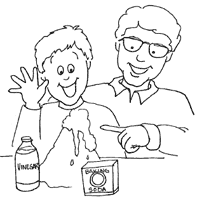 Early childhood science should be based upon experiences rather than
experiments. Children need to develop background knowledge and a
sense of cause and effect in a predictable world. According to Piaget, the
young child’s ability to think and reason is limited by a dependence on
experience. Children whose parents have provided a rich variety of
experiences (going to the zoo, caring for a pet, collecting insects, etc.)
develop background knowledge acting as a foundation upon which to
connect later abstract thinking. Children without background knowledge
have much greater difficulty in developing critical thinking skills.
Early childhood science should be based upon experiences rather than
experiments. Children need to develop background knowledge and a
sense of cause and effect in a predictable world. According to Piaget, the
young child’s ability to think and reason is limited by a dependence on
experience. Children whose parents have provided a rich variety of
experiences (going to the zoo, caring for a pet, collecting insects, etc.)
develop background knowledge acting as a foundation upon which to
connect later abstract thinking. Children without background knowledge
have much greater difficulty in developing critical thinking skills.
Sometime between the ages of six and eight most children move from “pre-operational” (relying on sensory experience for acquiring knowledge) into the “concrete operational” stage (developing the capacity for abstract thinking as long as it pertains to actual experience). As children mature, they will naturally begin to repeat procedures, perform experiments, and predict results. Science experiences promote critical thinking skills that enhance learning in every content area. A child’s ability to observe, describe, predict, problem solve, classify, interpret data, and communicate findings to others will have a greater impact on his success in life than any individual subject area. These critical thinking skills are the tools that promote in-depth learning of any subject.
Science Inquiry
Help your child to question, research, experiment, collect data, and draw conclusions.
 Encourage your child to question. Children
are naturally curious and ask their parents
hundreds of questions like these:
Encourage your child to question. Children
are naturally curious and ask their parents
hundreds of questions like these:
- Why is the sky blue?
- Why do things fall to the ground?
- How do seeds grow?
- What makes sound and music?
- Where do mountains come from?
- Ask questions about things that intrigue you, then model the process of searching to discover answers. “I wonder how that tree can grow two different kinds of apples?” Take your child to a tree nursery and find out more.
- Many children do not want to be wrong. They resist the risk of giving an answer of which they are not sure. Parents can model the process of forming a hypothesis. They can show their child that it is OK to be wrong. Scientists learn as much from theories that were proven wrong as from those that were proven right. For example, a parent might say, “The car won’t start. I wonder what the problem is. I wonder if I could be out of gas. (Show your child how to check the fuel level.) No, I have plenty of gas. I wonder if I am using the right key....”
Physical Science
Help your child to observe and describe the properties of matter, light, sound, and motion.
- Let your child help you bake a cake. Discuss the changes as you add each ingredient and as it is baked.
- Explore lights and shadows using a blank wall and a flashlight or projector. How does closeness to the light affect the size and clarity of the shadow? Go outside and trace your child’s shadow with chalk on the sidewalk several times during the day. Ask your child to observe and describe changes the shadow makes over time.
- Explore sounds of elastics that are stretched different lengths, or glass bottles filled with varying amounts of water. Also, try matching the sounds of assorted objects in containers.
Life Science
Help your child to explore plants/seeds, animals, growing/changing, the five senses, and health/nutrition.
- Ask your child, “Why do you think a duck has webbed feet and an eagle has claws on its feet?” Discuss unique adaptations that enable an animal to obtain food or survive.
- Encourage your child to make collections. Insect collections, leaf collections, or seashell collections promote early sorting and classification skills. Your child will compare items and discuss similarities and differences.
- As you visit the zoo or pet shop, go bird watching, or take family camping trips, provide enriching opportunities for your child to observe animals. Children love to read about animals and learn animal facts.
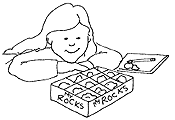 Earth and Space Science
Earth and Space Science
Help your child to learn about air, water, weather, earth, rocks, ocean, and space.
- Ask your child to help you record the shape of the moon on your family calendar each night.
- When you go camping, look at the stars with your child.
- Go for a walk in your neighborhood or hike in a nearby canyon. Collect rocks, explore a lake or a river, and draw maps showing the route you took and interesting features you discovered on your trip.
Science and Technology
Help your child explore and examine the uses of science and technology that impact his life.
- Help your child identify the uses of technology in your home (e.g., clocks, microwave, VCR, radio, electric can opener, dishwasher).
- Talk about how technology has changed over time. Invite grandparents to share methods they used in their childhood to communicate with others. Talk about the pros and cons of writing letters, sending e-mail, calling on the telephone, or traveling to speak face to face.
Science in Personal and Social Perspectives
Help your child to learn about personal health, changes in the environment, material resources, personal values—beauty, quiet places, and security.
- Encourage your child to tell you her ideas and listen to the explanation. Your child gains confidence in his thinking as he sees his ideas are valued by your careful listening. This will help him develop communication skills and an intensified interest in science. Listening also helps you to determine your child’s level of understanding. You will learn what your child knows and doesn’t know. As your child expresses his ideas orally, it also helps him recognize what he knows.
- As a family, share the beauty of a sunset, the mirror-like reflection on a lake, the whispering of the wind through the pine trees. Help your child value the magic of nature.
- Enhance your child’s awareness of the impact that science has on his own health and safety. Doctors, dentists, cooks, and PE teachers all use science skills in their profession. For example, a doctor uses problem solving to diagnose an illness.
Parent Connection to Social Studies
Young children learn through their senses and experiences. They touch, feel, smell, and taste things. They play imaginary games and interact with friends. Children’s everyday play and experiences give them a basis for social studies concepts they will learn in school.
- Human similarities and differences
- Basic human needs
- Human interdependence
- Rights and responsibilities
- People and the places they live
- People and the past
With just a little encouragement and direction, children can develop the vocabulary, awareness, and curiosity that will help them better understand and learn social studies. The following activities will help children gain the skills that lay the foundation for social studies.
Explore Human Similarities and Differences
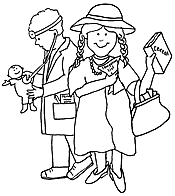 Examine neighborhood families and discuss similar and different
human characteristics with your child (e.g., family structures,
customs, habits, talents).
Examine neighborhood families and discuss similar and different
human characteristics with your child (e.g., family structures,
customs, habits, talents).- Help your child collect information about how different members of your family communicate with friends and relatives (e.g., visiting in person, talking on the telephone, writing letters, sending e-mail). Interview grandparents and compare the ways people communicate today with how their grandparents used to communicate with others.
- Investigate different languages spoken by people that your child knows. Help your child to learn a few words in a foreign language or sign language.
- Describe similarities and differences of each member of the family. What is the same? (e.g., body parts, emotions, basic needs) What is different? (e.g., hair color, shoe size, talents, favorite foods)
Basic Human Needs
- Discuss with your child the basic human needs for food, clothing, shelter, safety, security, and belonging. Talk about how your family provides for those basic needs. For example “What do each of us need to live? How do we get what we need? What are some things we have but do not actually need?”
- Ask your child to look through grocery ads and find the lowest price for a product.
Human Interdependence
- Talk about each family member and his or her role in the family. Discuss how each family member enriches the family and provides goods and services. For example, “Who provides our family with what we need? How do people work together to produce goods and services? How do we pay for goods and services?”
- As your family goes out into the community, take the opportunity to discuss the kinds of work that people do and the skills and tools needed to perform these jobs.
- Praise your child for helping the family (e.g., helping take out the trash, entertaining the baby while mom fixes dinner). Point out contributions he makes to the family and that all jobs are important.
Rights and Responsibilities
- Ask your child to help make a chart about family rules.
- Invite your child to participate in decision making and implementing a family activity.
- Hold family meetings and discuss ways to resolve differences of opinion and conflicts.
People and the Places They Live
 Purchase an inexpensive map and show your child how to use it
during a family vacation. As you travel, use directional words
(for example, “We’ll turn right at the corner. David’s house is
three blocks north of the gas station”).
Purchase an inexpensive map and show your child how to use it
during a family vacation. As you travel, use directional words
(for example, “We’ll turn right at the corner. David’s house is
three blocks north of the gas station”).- Make a map of your own yard or home, hide a small treat, and mark the spot on the map with an X. Have a family treasure hunt!
People and the Past
- Help your child keep a journal. Remind him of things that he couldn’t do when he was younger that he does with ease now.
- Explore changes in the neighborhood (e.g., construction of new homes, families moving out and in).
- Ask grandparents to describe games, chores, or activities that they did when they were children.
- Compare technology in your home with the technology your grandparents had in their home when they were growing up.
Artwork created by Nancy Bittner


 UTAH EDUCATION NETWORK
UTAH EDUCATION NETWORK

 Justin
Justin Braxton
Braxton Dani
Dani Rob
Rob Val
Val

